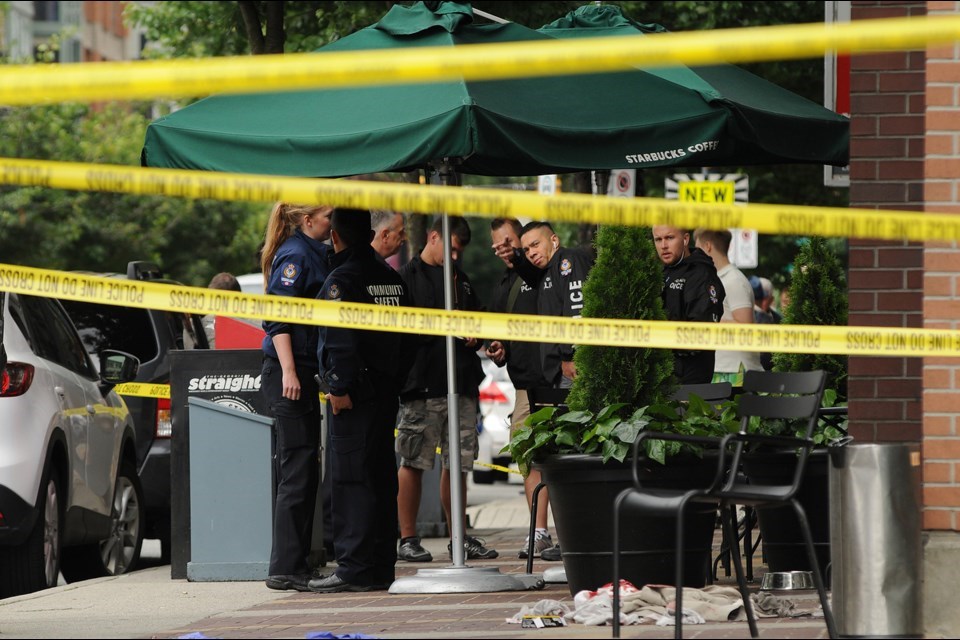Vancouver’s “crime severity index” remains higher than the national average but police have seen double-digit decreases over the past decade.
A new report that recently went before the Vancouver Police Board highlighted the decreases and why using the crime severity index (CSI) is a more accurate measurement of crime in the city than the “crime rate.”
What’s the difference?
Each year, Statistics Canada reports on the number and type of crimes coming to the attention of police. The crime rate is the more commonly known and understood crime measure.
Essentially, it’s the volume of crime recorded in a given jurisdiction for one calendar year.
What police view as a “downside” to the crime rate measurement is that each offence holds the same weight, no matter the seriousness of the incident.
So a violent robbery scores the same as an overnight car break-in.
“The CSI improves on the crime rate by conveying a better approximation of the overall victimization, safety and severity impact of crime,” the report said. “The basic principle behind the CSI is that more serious crimes carry a higher weight than less serious crimes.”
Sentencing data from courts
Within the CSI calculation, weights are given to each crime based on its severity, which is determined using sentencing data from Canada’s courts.
Weights are updated every five years and the current CSI weights apply from 2021 to 2026. As examples, the applicable CSI weights are currently 68 for a counterfeit currency case and more than 8,273 for a murder.
While the crime rate measures strictly the volume of crime, the CSI takes into account volume and severity.
For example, robberies accounted for 29.5 percent of the violent CSI in 2022, compared to just 8.1 per cent of the violent crime rate.
Similarly, break-and-enters accounted for 27.6 per cent of the non-violent CSI in 2022, compared to 8.6 per cent of the property crime rate.
As such, more serious crimes have more impact on the CSI.
'Double-digit improvements'
So how does Vancouver fare when the CSI is the sole measurement tool of crime?
“While Vancouver CSI scores remain higher than the national average, double-digit improvements were achieved over the past decade,” the report said.
“Decreases of 12.3%, 3.6% and 15.2% have been achieved in Vancouver since 2013 for the [overall] CSI, violent CSI and non-violent CSI, respectfully. These gains have allowed Vancouver to converge towards the national average.”
The CSI measurement comes with caveats, however.
“Despite the fact that some cases may have a profound impact on victims or may be significantly troubling, heinous, or impactful for the entire community, the CSI methodology does not differentiate between individual incidents within the same crime type,” the report said.
“For example, a hate-motivated assault on an elderly person or an unprovoked attack on a child would count the same in the CSI as a bar fight.”
'Core city effect'
Also, comparing Vancouver’s CSI to another city is not an exact science, with each city having various challenges and factors that affect measurement of crime. The “core city effect” is a big one, with Vancouver the epicentre for protests, large events, entertainment, tourism and bars.
There’s also the challenges with street disorder and social issues.
The under-reporting of crime is another factor highlighted in the report.
“These multiple factors are not taken into account when comparing crime rates or CSI between jurisdictions, which rely strictly on residential population in the denominator to standardize crime counts,” the report said. “This should be kept in mind when comparing CSI measures across jurisdictions.”
Still, while Vancouver’s violent CSI decreased 3.6 per cent since 2013 (109.9), the national violent CSI increased 32.0 per cent from 2013 (74.0) to 2022 (97.7). In fact, 2022 was the highest national violent CSI score since 2007.
The non-violent CSI includes all police-reported property violations and other Criminal Code violations including traffic offences, drug violations and all federal statutes.
Vancouver’s 2022 non-violent CSI was 87.2, down 3.7 per cent from 2021 (90.5). While the national average increased six per cent over the past decade (from 66.9 to 70.9), Vancouver’s non-violent CSI value decreased 15.2 per cent during the same period.





